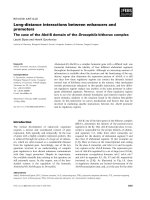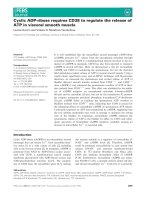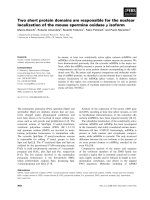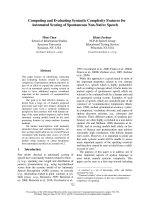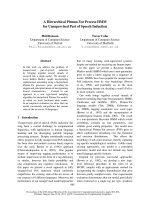Báo cáo khoa học: "Prospective multi-center trial utilizing electronic brachytherapy for the treatment of endometrial cancer" ppsx
Bạn đang xem bản rút gọn của tài liệu. Xem và tải ngay bản đầy đủ của tài liệu tại đây (402.4 KB, 6 trang )
Dickler et al. Radiation Oncology 2010, 5:67
/>Open Access
RESEARCH
© 2010 Dickler et al; licensee BioMed Central Ltd. This is an Open Access article distributed under the terms of the Creative Commons
Attribution License ( which permits unrestricted use, distribution, and reproduction in
any medium, provided the original work is properly cited.
Research
Prospective multi-center trial utilizing electronic
brachytherapy for the treatment of endometrial
cancer
Adam Dickler*
1
, Mohamed Y Puthawala
2
, John P Thropay
3
, Ajay Bhatnagar
4
and Gary Schreiber
5
Abstract
Background: A modified form of high dose rate (HDR) brachytherapy has been developed called Axxent Electronic
Brachytherapy (EBT). EBT uses a kilovolt X-ray source and does not require treatment in a shielded vault or a HDR
afterloader unit. A multi-center clinical study was carried out to evaluate the success of treatment delivery, safety and
toxicity of EBT in patients with endometrial cancer.
Methods: A total of 15 patients with stage I or II endometrial cancer were enrolled at 5 sites. Patients were treated with
vaginal EBT alone or in combination with external beam radiation.
Results: The prescribed doses of EBT were successfully delivered in all 15 patients. From the first fraction through 3
months follow-up, there were 4 CTC Grade 1 adverse events and 2 CTC Grade II adverse events reported that were EBT
related. The mild events reported were dysuria, vaginal dryness, mucosal atrophy, and rectal bleeding. The moderate
treatment related adverse events included dysuria, and vaginal pain. No Grade III or IV adverse events were reported.
The EBT system performed well and was associated with limited acute toxicities.
Conclusions: EBT shows acute results similar to HDR brachytherapy. Additional research is needed to further assess the
clinical efficacy and safety of EBT in the treatment of endometrial cancer.
Introduction
Endometrial cancer is the most common gynecologic
cancer, and an estimated 42,160 new cases of endometrial
cancer were diagnosed in 2009 [1]. The standard manage-
ment for endometrial cancer is a total abdominal hyster-
ectomy and bilateral salpingo-oophorectomy (TAH-BSO)
with or without lymph node sampling. The vagina is the
most common site of recurrence, and whole pelvic radio-
therapy, vaginal cuff brachytherapy, or both types of radi-
ation therapy may follow surgical treatment. Radiation
therapy significantly decreases the risk of local regional
recurrence and has been associated with improved sur-
vival in patients with stage IC disease [2-4].
Vaginal brachytherapy is often employed in the treat-
ment of endometrial cancer, either alone or in combina-
tion with external beam radiation. Vaginal brachytherapy
has typically been delivered using a vaginal cylinder and a
high dose rate (HDR) Iridium-192 radiation source. A
modified form of HDR brachytherapy has been devel-
oped called Axxent Electronic Brachytherapy (EBT). The
EBT device uses a 50 kilovoltage (kV) electronic X-ray
source, which does not require a shielded vault for treat-
ment or an HDR afterloader unit. The dosimetric proper-
ties of the EBT and Ir-192 sources were compared in the
treatment of endometrial cancer [5]. Both sources pro-
vided equivalent target volume coverage, and EBT was
associated with increased bladder and rectum sparing
compared to Ir-192.
A prospective, multi-center clinical study was carried
out to evaluate the success of treatment delivery, safety
and toxicity of EBT as post-surgical adjuvant radiation
therapy in patients with early-stage endometrial cancer.
The results of this trial represent the first clinical report
of EBT in the treatment of endometrial cancer.
* Correspondence:
1
Little Company of Mary Hospital, Evergreen Park, IL USA
Full list of author information is available at the end of the article
Dickler et al. Radiation Oncology 2010, 5:67
/>Page 2 of 6
Methods
The study was approved at the institutional review boards
at each of the five participating sites. Each patient was
consented prior to enrollment in the trial.
Patients
This trial utilized the FIGO staging system for endome-
trial cancer developed in 1988. Eligibility for the trial
included patients with Stage I & II endometrial cancer,
excluding Stage IA Grade 1, who had undergone a TAH-
BSO. Exclusion criteria included patients with collagen
vascular disease, scleroderma, or active lupus.
Materials
The EBT system consists of the disposable X-ray source,
vaginal applicators, the controller unit, and the base plate
and clamp. The miniature X-ray source produces 50 kilo-
volt X-rays at its tip and can be translated within the
applicator to provide a predictable dose of radiation to
the tissue surrounding the cylinder. The vaginal applica-
tors are cylinders made of medical-grade polymers and
provide transmission characteristics specifically for the
low energy X-rays emitted by the EBT source. A vaginal
cylinder size was selected for each patient, and 25 mm, 30
mm, 35 mm cylinders were utilized in the study. The
applicator was inserted just prior to treatment and
removed following treatment on each treatment visit.
The base plate and clamp provide stabilization of the
applicator during radiation treatment. The mobile con-
troller unit provides power to the X-ray source and con-
tains the user interface.
Treatment
If vaginal brachytherapy was to be administered as the
sole radiation treatment modality, sites were given the
option of treating with a prescription dose 7.0 Gy x 3 to
0.5-cm depth or 5.5 Gy x 4 to 0.5-cm depth. If vaginal
brachytherapy was to be delivered in conjunction with
external beam radiation therapy (EBRT), sites first deliv-
ered 45 Gy EBRT in 25 fractions to the pelvis. At the
completion of EBRT, sites were given the option of treat-
ing with an EBT prescription dose of 6.0 Gy x 3 to the
vaginal surface or 8.0 Gy x 2 to the vaginal surface.
Treatment planning was performed according to the
standard of care at the treating institution and typically
with BrachyVision™ treatment planning software (Varian
Medical Systems, Palo Alto, CA) or Plato™ treatment
planning software (Nucletron, Columbia, MD).Three
dimensional treatment planning was completed for each
patient prior to the first brachytherapy fraction. Both 2D
and 3D treatment planning were permitted prior to each
fraction according to the physician's standard of care, but
a 3D treatment plan based on computed tomography
(CT) was required so that normal tissue doses could be
calculated. CT images were recorded prior to each frac-
tion on all patients to verify correct applicator placement.
A CT scan was performed with the vaginal applicator in
place and the patient in a supine position. The CT scan
encompassed a superior border of L5/S1 and an inferior
border of the ischial tuberosities. TG-43 parameters spe-
cific to EBT were used to compute the delivered dose
[5,6]. Patients were followed at 1 month and 3 months
post-treatment.
Endpoints
The primary endpoints of the study were the successful
delivery of the prescribed radiation dose and treatment-
related adverse events. Adverse events and severity were
recorded during treatment and at the 1- and 3-month fol-
low-up visits. Adverse events were graded according to
the common terminology criteria (CTC) version 3.0. The
n (number of observations) and proportion is reported
for each endpoint. For continuous variables, the mean,
standard deviation, and range is presented. Categorical
variables are described using proportions and frequen-
cies.
Results
Patient Population
A total of 15 patients were enrolled in the study. The first
patient was enrolled in September 2008, and enrollment
was completed in October 2009. Patient and disease
characteristics are listed in Table 1. The mean age of the
patients was 63.2 years of age (range 41.6-72.7). Nearly
half (46.7%) had FIGO Stage IB cancer; 5 (33.3%) had
Stage IC, and 3 (20.0%) had Stage IIA. All patients were
followed for 3 months.
Treatment
The EBT vaginal brachytherapy was successfully deliv-
ered for all 48 treatments in the 15 patients. In the 10
patients who received EBT alone, the prescription dose
was 7.0 Gy x 3 fractions to a 0.5 cm depth in 7 patients
and 5.5 Gy x 4 fractions to a 0.5 cm depth in 3 patients
(Table 2). In the 5 patients who received EBRT before
EBT, the EBRT dose was 45 Gy in 25 fractions in 4
patients delivered by IMRT in 3 and three dimensional
conformal radiation therapy (3D-CRT) in 1, and 50.4 Gy
in 28 fractions in 1 patient delivered by 3D-CRT. Follow-
ing EBRT, the EBT prescription dose was 6.0 Gy x 3 frac-
tions to the vaginal surface in 3 patients, 5.0 Gy x 4 to the
vaginal surface in 1 patient, and 8.0 Gy x 2 to the vaginal
surface in 1 patient. The mean treatment time was 4.9
minutes. The brachytherapy treatment summary and
applicator size used for each patient is listed in Table 1.
CT scans were used to evaluate the dose to normal tis-
sues and volume of treatment after applicator insertion
and prior to the first fraction of brachytherapy. The
length of vagina treated ranged from 4.0 to 7.0 cm with a
Dickler et al. Radiation Oncology 2010, 5:67
/>Page 3 of 6
mean length of 5.28 cm. The dosimetric data is summa-
rized in Table 3.
The EBT system performed without major malfunc-
tion. No technical issues occurred with the controller or
the applicators. At one site there was a source issue
related to the electrical connection, which was traced to a
loose clamp assembly. This issue was easily rectified, and
treatment was completed as scheduled.
Adverse Events
An independent data safety monitor adjudicated the
adverse events. Six patients reported adverse events pos-
sibly or probably related to the EBT treatment including 4
CTC Grade I toxicities and 2 CTC Grade II toxicities
(Table 4). There were no treatment related adverse events
reported at the time of treatment and there were no seri-
ous adverse events reported in the study. One patient
developed Grade I dysuria at her 1-month follow-up visit.
Additional Grade I adverse events reported by one
patient each included mild mucosal atrophy, vaginal dry-
ing, and rectal bleeding. A patient reported both Grade II
dysuria and pelvic pain at her 1-month follow-up visit.
Nine of 15 patients reported no treatment related adverse
events during treatment through the 3-month follow-up
visits.
Discussion
Post-operative vaginal brachytherapy was compared with
external beam radiation therapy (EBRT) in 427 patients
with stage I or IIA endometrial cancer in a report of the
PORTEC-2 trial [7]. The rates of overall survival, disease
free survival, and vaginal relapse were not significantly
different between the two treatment modalities. How-
ever, the rates of Grade I-II gastrointestinal toxicity were
significantly lower in the vaginal brachytherapy arm (27/
215 patients or 12.6%) as compared with the EBRT arm
(112/208 patients or 53.8%). The authors of this study
concluded that vaginal brachytherapy alone should be the
adjuvant treatment of choice for patients with high-inter-
mediate risk endometrial cancer [7]. Those results may
lead to more patients being treated with post-surgical
vaginal brachytherapy alone for early stage endometrial
cancer. This combined with patients who receive both
EBRT and vaginal brachytherapy likely will lead to an
increasing utilization of HDR vaginal brachytherapy.
Currently, the most common method of delivering vag-
inal brachytherapy relies on a radioactive isotope, Irid-
ium-192, which is not feasible for all centers. Many
centers do not have an HDR afterloader device, which is
Table 1: Patient Characteristics
Mean Age (Range) Years 63.2 (41.6-72.7)
Race n (%)
Caucasian 11 (73.3%)
Hispanic 1 (6.7%)
Asian 2 (13.3%)
Other 1 (6.7%)
FIGO Cancer Stage
IB 7 (46.7%)
IC 5 (33.3%)
IIA 3 (20.0%)
Tumor Grade
Grade 1 3 (20.0%)
Grade 2 8 (53.3%)
Grade 3 4 (26.7%)
Depth of Myometrial Invasion
≤1/3 8 (53.3%)
> 1/3 and ≤ 2/3 5 (33.3%)
> 2/3 2 (13.3%)
Mean Time from Hysterectomy to 1st
EBT Treatment
113.1 Days
(Range) (37-787) Days
Applicator Sizes n (%)
25 mm 7 (46.7%)
30 mm 7 (46.7%)
35 mm 1 (6.7%)
Table 2: Total Prescribed Dose (Gy) of EBT in patients categorized by whether they received EBRT in addition to EBT
EBT Alone EBT + EBRT Prescription
Dose (Gy) 5.5Gy x 4Fx to 0.5 cm 7Gy x 3Fx to 0.5 cm 8Gy x 2Fx to Vaginal Surface 6Gy x 3Fx to Vaginal Surface 5Gy x 4Fx to 0.5 cm
# of patients (%) 3 (20.0%) 7 (46.7%) 1 (6.7%) 3 (20.0%) 1 (6.7%)
Gy = gray, EBRT= external beam radiation therapy, Fx = Fraction, cm = centimeter
Dickler et al. Radiation Oncology 2010, 5:67
/>Page 4 of 6
required with an Ir-192 source. In addition, many centers
have a single shielded radiation vault for both their EBRT
and HDR patients. This can lead to logistical difficulties
in scheduling patients at a busy radiation center. Elec-
tronic brachytherapy (EBT) was developed to make
brachytherapy more accessible for patients. EBT treat-
ment does not require a shielded radiation bunker and
thus increases the settings in which brachytherapy treat-
ments can be performed.
This report describes the first prospective clinical trial
of vaginal EBT for the treatment of endometrial cancer.
EBT treatment was delivered successfully for all 48 frac-
tions of treatment in this study. The EBT device per-
formed as expected with minimal technical issues. EBT
was well tolerated with no serious adverse events. Six
patients reported Grade 1-2 adverse events. Previous
reports of EBT for accelerated partial breast irradiation
(APBI) demonstrated an acceptable safety profile similar
to that seen with Ir-192 based APBI [8]. Previous reports
with Ir-192 based vaginal brachytherapy have shown it to
be a very well tolerated procedure. Fayed, et al., reported
only a 4% risk of Grade III/IV toxicity in 175 patients
treated with HDR. The authors also noticed that the com-
plication risk was higher if the patients also received
EBRT [9]. Weiss et al and MacLoed et al have both
reported on studies with over 100 patients treated with
HDR brachytherapy alone and described no Grade III/IV
toxicity [10,11]. It should be noted that these studies uti-
lizing Ir-192 have larger patient numbers and longer fol-
low-up than the current series.
The EBT radiation fractionation schedules utilized in
this study were derived from the American Brachyther-
apy Society Recommendations for the suggested doses of
Ir-192 HDR alone or in combination with EBRT [12]. It
has previously been shown by Dickler, et al., in a dosimet-
ric comparison that EBT offers similar target volume cov-
erage and increased bladder and rectum sparing
compared to Ir-192 based vaginal brachytherapy [5]. As a
result, using the same radiation fractionation as used for
Ir-192 treatment, it is reasonable to expect similar or pos-
sibly less bladder and rectal toxicity with EBT treatment.
In the current study at 3 months follow-up, there have
Table 3: Dosimetry Analysis: The percent of the planned
target volume (PTV) or organ receiving 50, 95, 100, or
150% of the prescribed dose at depth followed by the
maximum point dose in cGy to the indicated organ
Mean % ± SD Range
%V95 91.0 ± 13.6 49.0 - 103.0
%V100 87.6 ± 13.7 48.0 - 98.0
%V150 34.1 ± 15.6 3.3 - 69.7
Bladder %V50 11.5 ± 9.7 0 - 40.2
Rectal %V50 17.4 ± 10.9 0 - 36.0
Max Point Dose to Bladder 701.2 ± 169.3 cGy 467 - 1087 cGy
Max Point Dose to Rectum 775.0 ± 355.4 cGy 100 - 1584 cGy
Max Point Dose to Small
Bowel
421.3 ± 391.1 cGy 0 - 1188 cGy
Table 4: Number (%) of patients with adverse events reported at the one-month (1 mo) or three-month (3 mo) follow-up
visit that are possibly related or probably related to the EBT treatment
1 Month Visit
Pt # RT Adverse Event Grade N (%) Visit Relationship to
EBT Treatment
Visit Resolved
A EBT & EBRT Dysuria 1 1 1 mo Possibly related Unresolved at 3 mo. visit
B EBT & EBRT Dysuria 2 1 1 mo Possibly related Resolved at 3 mo. visit
C EBT & EBRT Vaginal pain 2 1 1 mo Probably related Resolved at 6 wk. visit
3 Month Visit
Pt # RT Adverse Event Grade N (%) Visit Relationship to
EBT Treatment
Visit Resolved
D EBT Mucosal atrophy 1 1 3 mo Probably Related Reported at 3 mo. visit
EEBTRectal bleeding113 moProbably Related Reported at 3 mo. visit
F EBT & EBRT Vaginal Drying 1 1 3 mo Possibly Related Reported at 3 mo. visit
EBT = Electronic Brachytherapy, EBRT = External Beam Radiation Therapy RT = radiation therapy treatment, mo = month, wk = week
Dickler et al. Radiation Oncology 2010, 5:67
/>Page 5 of 6
been no reports of Grade III/IV toxicity, and 9 of 15
patients have reported no toxicity at all. This is consistent
with previous published reports using Ir-192 brachyther-
apy [7,10,11].
Although the study by Dickler, et al., showed similar
target coverage between EBT and Ir-192 HDR treatment,
EBT was associated with increased "hot spots" in the vag-
inal canal [5]. Specifically, the %V150 (percent of the tar-
get volume receiving 150% of the prescription dose) was
58.9% vs. 35.8% for the EBT and Ir-192 treatments,
respectively. It is not known whether an increased vol-
ume of the vaginal canal being exposed to higher radia-
tion doses will put patients at an increased risk for vaginal
side effects such as stenosis or vaginal shortening. At 3
months follow-up, there were no incidences of vaginal
stenosis or shortening in the current study. Of note,
Noyes and investigators from University of Wisconsin
have reported their results treating 63 patients with HDR
and vaginal ovoids with vaginal surface doses of 16.2 Gy.
The authors reported no incidence of Grade III/IV side
effects using much higher vaginal surface doses than used
in the current study [13]. Further follow-up will be
needed to determine if late vaginal side effects occur at an
increased rate with EBT treatment.
Conclusions
The EBT system performed well and was associated with
limited acute adverse events. The prescribed dose was
successfully delivered in all 15 patients. Acute results are
similar to those using HDR brachytherapy. Further
research with EBT will be needed to establish its clinical
efficacy and long-term toxicity in the treatment of
patients with endometrial cancer.
List of Abbreviations
AE: Adverse events; CT: Computerized tomography;
CTC: Common Terminology Criteria; EBRT: External
Beam Radiation Therapy; EBT: Electronic Brachytherapy;
Gy: Gray; HDR: High Dose Rate; Ir- 192: Iridium 192; kV:
kilovoltage; QID: Four times per day, TAH-BSO: total
abdominal hysterectomy and bilateral salpingo-
oophorectomy
Author's Information
AD has completed dosimetric comparisons of electronic
brachytherapy and iridium-192 and requested to proceed
with a small study on the initial experience using elec-
tronic brachytherapy for the treatment endometrial can-
cer following TAH-BSO.
Competing interests
We disclose to Radiation Oncology the following potential conflicts of interest:
Author Disclosures: Dr. Dickler is on the scientific advisory board for Xoft, Inc.
Authors' contributions
All five authors contributed significantly to this manuscript by contributing to
the study data collection, reviewing the data analyses, revising, and approving
the final manuscript. All authors contributed to the study design of this first
experience.
Acknowledgements
The authors wish to thank all site participants and investigators who supported
this research, and the patients for participating in this study. A medical writer,
Leslie Todd, assisted with preparation of this manuscript, and Xoft, Inc, com-
pensated her time. Funding for this study was provided by Xoft, Inc.
Author Details
1
Little Company of Mary Hospital, Evergreen Park, IL USA,
2
Rhode Island
Hospital, Providence, RI USA,
3
Beverly Oncology and Imaging Centers,
Montebello, CA USA,
4
Cancer Treatment Services Arizona, Casa Grande, AZ
USA and
5
Swedish Covenant Hospital, Chicago, IL USA
References
1. Jemal A, Siegel R, Ward E, Hao Y, Xu J, Thun MJ: Cancer statistics 2009. CA
Cancer J Clin. 2009, 59(4):225-49.
2. Scholten AN, van Putten WL, Beerman H, Smit VT, Koper PC, Lybeert ML,
Jobsen JJ, Warlam-Rodenhuis CC, De Winter KA, Lutgens LC, van Lent M,
Creutzberg CL: Postoperative radiotherapy for stage I endometrial
carcinoma: long-term outcome of the randomized PORTEC trial with
central pathology review. Int J Radiat Oncol Biol Phys 2005, 63:834-38.
3. Keys HM, Roberts JA, Brunetto VL, Zaino RJ, Spirtos NM, Bloss JD, Pearlman
A, Maiman MA, Bell JG: A phase III trial of surgery with or without
adjunctive external pelvic radiation therapy in intermediate risk
endometrial adenocarcinoma: a gynecologic oncology group study.
Gynecol Oncol 2004, 92:744-51.
4. Lee CM, Szabo A, Shrieve DC, Macdonald OK, Gaffney DK: Frequency and
Effect of Adjuvant Radiation Therapy Among Women with Stage I
Endometrial Adenocarcinoma. JAMA 2009, 295:389-97.
5. Dickler A, Kirk MC, Coon A, Bernard D, Zusag T, Rotmensch J, Wazer DE: A
dosimetric comparison of xoft axxent electronic brachytherapy and Ir-
192 hdr brachytherapy in the treatment of endometrial cancer.
Brachytherapy 2008, 7(4):351-4.
6. Rivard MJ, Davis SD, DeWerd LA, Rusch TW, Axelrod S: Calculated and
measured brachytherapy dosimetry parameters in water for the Xoft
Axxent X-Ray Source: An electronic brachytherapy. Med Phys 2006,
33:4020-32.
7. Nout RA, Smit VT, Putter H, Jurgenliemk-Schulz IM, Jobsen JJ, Lutgens LC,
van der Steen-Banasik EM, Mens JW, Slot A, Kroese MC, van Bunningen
BN, Ansink AC, van Putten WL, Creutzberg CL: Vaginal brachytherapy
versus pelvic external beam radiotherapy for patients with
endometrial cancer of high-intermediate risk (PORTEC-2): an open
label non-inferiority, randomized trial. Lancet 2010, 375:816-23.
8. Mehta VK, Algan O, Griem KL, Haile K, Wazer DE, Stevens RE, Chadha M,
Kurtzman S, Modin SD, Dowlatshahi K, Elliott KW, Rusch TW: Experience
with an electronic brachytherapy technique for intracavitary
accelerated partial breast irradiation. Am J Clin Oncol 2010. published
online April
9. Fayed A, Mutch DG, Rader JS, Rader JS, Gibb RK, Powell MA, Wright JD,
Elnaga I, Zoberi I, Grigsby PW: Comparison of high-dose-rate and low-
dose-rate brachytherapy in the treatment of endometrial cancer. Int J
Radiat Oncol Biol Phys 2007, 67(2):480-4.
10. Weiss E, Hirnle P, Arnold-Bofinger H, Hess CF, Bamberg M: Adjuvant
vaginal high-dose-rate afterloading alone in endometrial carcinoma:
patterns of relapse and side effects following low-dose therapy.
Gynecol Oncol 1998, 71:72-6.
11. MacLeod C, Fowler A, Duval P, D'costa I, Dalrymple C, Elliott P, Atkinson K,
Firth I, Carter J: High-dose-rate brachytherapy alone post-hysterectomy
for endometrial cancer. Int J Radiat Oncol Biol Phys 1998, 42:1033-9.
12. Nag S, Erickson B, Parikh S, Gupta N, Varia M, Glasgow G: The American
brachytherapy society recommendations for high-dose-rate
brachytherapy for carcinoma of the endometrium. Int J Radiat Oncol
Biol Physics 2000, 48(3):779-90.
Received: 13 May 2010 Accepted: 20 July 2010
Published: 20 July 2010
This article is available from: 2010 Dickler et al; licensee BioMed Central Ltd. This is an Open Access article distributed under the terms of the Creative Commons Attribution License ( which permits unrestricted use, distribution, and reproduction in any medium, provided the original work is properly cited.Radiation Onc ology 2010, 5:67
Dickler et al. Radiation Oncology 2010, 5:67
/>Page 6 of 6
13. Noyes WR, Bastin K, Edwards SR, Buchler DA, Stitt JA, Thomadsen BR,
Fowler JF, Kinsella TJ: Postoperative vaginal cuff irradiation using high
dose rate remote afterloading: a phase II clinical protocol. Int J Radiat
Oncol Biol Phys 1995, 32:1439-43.
doi: 10.1186/1748-717X-5-67
Cite this article as: Dickler et al., Prospective multi-center trial utilizing elec-
tronic brachytherapy for the treatment of endometrial cancer Radiation
Oncology 2010, 5:67



